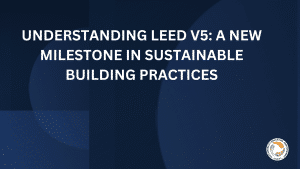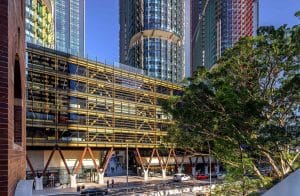Most people who are in some way associated with sustainable architecture must have heard of the terms LEED AP and WELL AP. While the former credential indicates that the professional has the knowledge and skills to facilitate the LEED certification process, the latter’s aim is to improve human health and well-being through the built environment.
Where LEED overall is about sustainability, building materials, energy efficiency and the environment, the WELL Building Standard is all about monitoring the impact of the built environment on human health and wellness. It should be noted that WELL and LEED complement each other, or one can say that WELL takes off where LEED signs off. While LEED is more about becoming energy/resource efficient and saving on utility bills, WELL motivates you to want to better your surroundings to live a healthier lifestyle.
Let us understand a bit more about the LEED AP and WELL AP credentials before comparing the two.
Who is a LEED AP?
LEED is an internationally recognized green building certification system that provides third-party verification that a particular building or complex was designed and constructed keeping in mind all the essential criteria of green design. LEED is changing the way buildings are designed, built, operated, and maintained. Its benefits are clear and proven in regard to cost savings, energy conservation, reduced water consumption, and improved indoor air quality.
Now as people across the globe become more aware of the benefits of sustainable architecture, the demand for LEED certification for buildings increases – and so does the demand for LEED Accredited Professionals (APs). A LEED Accredited Professional is a person who has passed a test that covers green building knowledge in general and LEED specifically.
Currently, it is possible to earn a LEED AP credential for three rating systems: existing buildings, commercial interiors and new construction.
It should be noted that earning a LEED AP credential requires specializing in a specific field. The specialization of LEED designation resembles the specialization of graduate school. To gain higher levels of mastery in a subject, one must specialize. You can specialize in each of the different rating systems of LEED that are listed below –
LEED AP Building Design + Construction (LEED AP BD+C)
This applies to whole buildings that are being newly constructed or going through a major renovation and suits professionals with expertise in the design and construction phases of green buildings, serving the commercial, residential, education and healthcare sectors.
LEED AP Operations + Maintenance (LEED AP O+M)
This applies to existing whole buildings that want to be recognized for policies and performance, and distinguishes professionals implementing sustainable practices, improving performance, heightening efficiency and reducing environmental impact in existing buildings through enhanced operations and maintenance.
LEED AP Interior Design + Construction (LEED AP ID+C)
This applies to partial-building projects that are exclusive to interiors and serves participants in the design, construction and improvement of commercial interiors and tenant spaces that offer a healthy, sustainable and productive work environment.
LEED AP Neighborhood Development (LEED AP ND)
This applies to new land development projects or redevelopment projects containing residential uses, nonresidential uses, or a mix. It is for individuals participating in the planning, design and development of walkable neighborhoods and communities.
LEED AP Homes
This applies to single family homes, low-rise multi-family (one to three stories), or mid-rise multi-family (four to six stories). This credential is suited for those involved in the design and construction of healthy, durable homes that use fewer resources and produce less waste.
Also read: Top 10 Tips to Pass LEED Green Associate Exam in 2020
Who is a WELL AP?
Launched in 2014 after six years of research and development, the WELL Building Standard is a performance-based system for measuring, certifying, and monitoring features of the built environment that impact human health and wellbeing. It is the world’s first building certification that focuses exclusively on human health and wellness.
The WELL Standard sets performance requirements in seven concepts relevant to occupant health in the built environment – air, water, nourishment, light, fitness, comfort and mind. All these concepts are based on medical research concerning how environments affect human health.
So basically, WELL is grounded in a body of medical research that explores the connection between the buildings where we spend more than 90 percent of our time, and the health and wellness of its occupants. WELL Certified spaces and WELL Compliant core and shell developments can help create a built environment that improves the nutrition, fitness, mood, and sleep patterns.
In short, WELL is more about human sustainability, and professionals who have specialization in the WELL Building Standard and have passed the WELL AP exam are known as WELL APs.
Which of the two credentials is more popular?
Since LEED was launched almost two decades before WELL, it is understandable that it is way more popular and established, although WELL is also fast becoming a much sought after course among people in sustainable architecture. The number of LEED APs across the world is estimated to be over 200,000 whereas the number of WELL APs and registrants is a little above 10,000. This is proof of the fact that LEED enjoys much more popularity among the two.
LEED AP Vs WELL AP – Exam difficulty level
It is true that the WELL AP exam is not exactly an easy one. After all, it was developed using GBCI’s rigorous test development best practices, and is based on the expertise of leading building industry practitioners, academic researchers and physicians in the field of design, health and wellness in the built environment.
However, when you compare it with the LEED AP exam, the latter is more difficult in comparison as it involves an advanced in-depth knowledge of green building practices and by extension, an even greater commitment towards sustainable building. As mentioned before, earning a LEED AP credential requires specializing in a specific field. The specialization of LEED designation resembles the specialization of graduate school.
But don’t worry! We, at GBRI, are committed to making the difficult task of passing both LEED AP and WELL AP exams as easy as possible for you!
GBRI – WELL AP and LEED AP exam prep courses
With GBRI’s study materials, you can earn your WELL AP in as little as 5 weeks. Based on your schedule and preferences, attend live exam prep sessions online OR utilize self-paced online on-demand exam prep modules for your convenience.
So basically, GBRI WELL AP Exam Prep Package offers everything you need to pass the exam! It includes:
- 5 Simulated Practice Exams/Mock Tests-700+ Test Questions With Answer Explanations
- Study Guide, Live Study Sessions
- Self- Paced Online Study Modules
- Flash Cards, Memory Charts and MP3 Voice Files
- Remote Tutor Assistance
It should be noted that GBRI’s Study Guide and On-demand Modules are both stand-alone exam prep resources. Depending on your preference or learning style, you may choose one over the other.
In addition to the WELL AP exam prep course, GBRI also offers all-inclusive LEED exam preparation courses for the LEED AP BD+C and O+M exams. The courses come with several features to ensure best ways to pass the exam including:
- Study Guide and Online Modules
- Practice Exams containing over 500 practice questions accompanied by explanations, increasing understanding of required principles
- Live and on-demand access for a full year
- Flashcards & Memorization Charts
- Audio Files
- Reference and study materials
- Instant access
- Remote Tutor Assistance
GBRI’s LEED AP exam preparation programs include access to all LEED Green Associate study materials for students interested in taking the combined LEED Green Associate and LEED AP exam. GBRI LEED Exam Prep is taught in the context of a real LEED v4 project giving you the LEED project experience you need to ace the LEED v4 Green Associate and LEED AP Exam.
Exam Eligibility Requirements for LEED AP and WELL AP
Candidates seeking LEED AP credential must hold a current LEED Green Associate credential and be 18 years of age or older. GBCI recommends that candidates taking the LEED AP with specialty exam have prior LEED project experience. It is important to note that LEED credentials are valid for two-year periods. LEED APs with a specialty must acquire 30 hours of continuing education every 2 years to maintain their credential. In addition to continuing education hours, individuals must also pay a biennial renewal fee to the USGBC.
For WELL AP, GBCI recommends that candidates have exposure to concepts around health and wellness in the built environment through educational courses, volunteering or work experience prior to testing. However, unlike the LEED AP (with specialty) exams, there is no prerequisite credential you have to earn to take the WELL AP exam. Candidates must be 18 years old.
Also Read: How can one become a LEED certified professional in India?
Conclusion
To sum up, despite their different areas of focus, LEED and WELL share a considerable overlap. For instance, LEED requires a ventilation rate that meets ASHRAE 62.1-2010, while WELL requires the stricter 2013 version. Meeting WELL’s ventilation benchmark would mean your project meets LEED’s as well. LEED includes permanent entryway systems in an optional Enhanced IAQ Strategies credit; WELL moves entryway walk-off systems to its own credit and makes it a prerequisite for all but interiors-only projects.
So it is always a good idea to go for WELL AP if you already have a LEED AP credential in your kitty.











